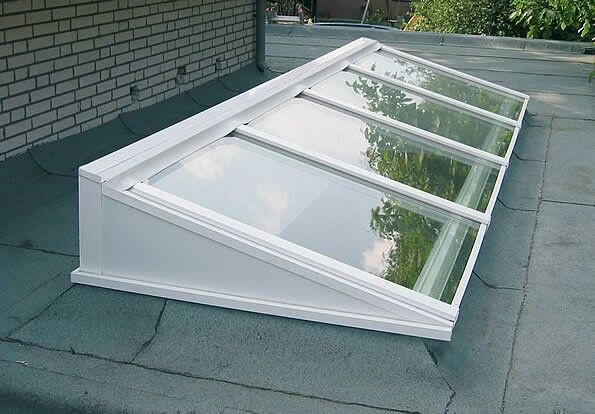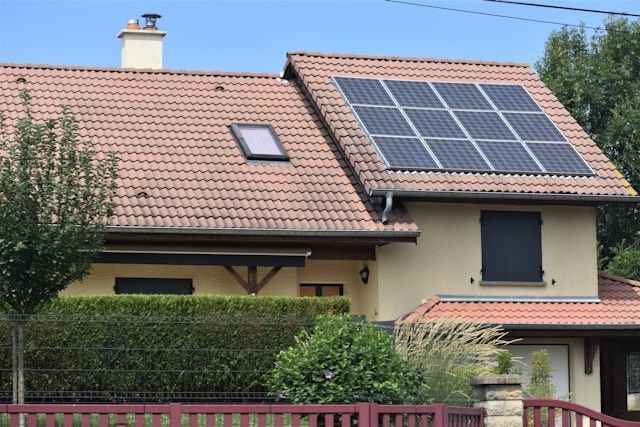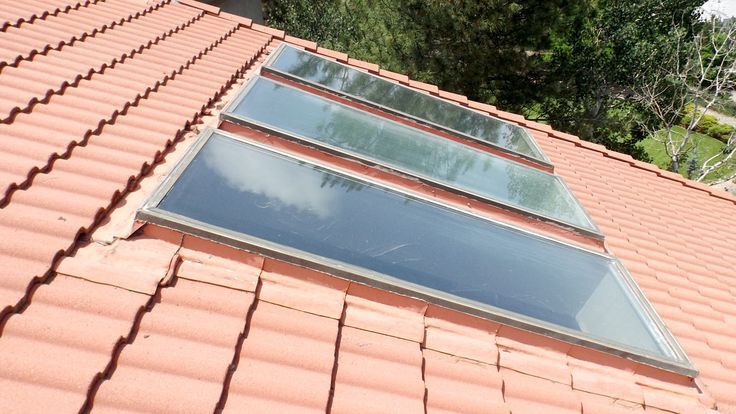
How to Care for a Roof with Skylights: Best Maintenance Practices
Skylights add natural light, improve energy efficiency, and enhance the overall aesthetic of a property, making them a popular feature in both residential and commercial buildings. However, maintaining a roof with skylights requires extra care since improperly sealed or damaged skylights can lead to water infiltration, energy loss, and structural damage.
In 2024, residential roofing services contributed $14.96 billion to the total revenue generated by the roofing industry, highlighting the importance of regular maintenance and professional inspections to catch small issues before they escalate into costly repairs.
Here are five best maintenance practices to keep a roof with skylights in top condition and extend its lifespan.
Table of Contents
Key Takeaways
|
1. Schedule Regular Roof Inspections
Regular roof inspections are essential for maintaining the integrity of a roof with skylights. Over time, skylight seals and flashing can deteriorate due to weather, debris, and normal wear and tear. Professional inspections help identify early signs of damage, allowing for timely repairs and avoiding costly structural issues.
How Professional Inspections Keep Skylights in Good Condition
- Check for Seal Integrity: Professional roof inspections focus on the condition of the skylight seals. If the seals are cracked or loose, moisture can seep through and cause water damage or mold growth.
- Assess Flashing Performance: Inspectors examine the flashing around the skylight to ensure it’s securely attached and free of corrosion or separation. Damaged flashing can allow water to penetrate the roof, leading to leaks and structural weakening.
- Identify Structural Weakness: Roof inspections include checking for sagging, cracks, or soft spots around the skylight. Early detection of structural issues prevents further damage and ensures the roof can handle the additional weight and pressure from the skylight.
2. Clean Skylights and Surrounding Roof Areas Regularly
Dirt, debris, and buildup around skylights can lead to water pooling, reduced energy efficiency, and damage to roofing materials. Regular cleaning ensures that skylights stay clear, allowing maximum natural light to enter the building while preventing moisture-related issues. Proper cleaning is an essential part of both residential roof maintenance and commercial roof maintenance.
How to Keep Skylights and Roof Areas Clean
- Remove Debris After Storms: Leaves, branches, and dirt can accumulate on the roof and around skylights after storms. Removing debris promptly prevents moisture buildup and reduces the risk of damage to roofing materials and skylight seals.
- Use Safe, Non-Abrasive Cleaners: Cleaning the skylight glass with a mild, non-abrasive cleaner helps prevent scratches and discoloration. Professional roofing solutions often recommend using a soft cloth or sponge to avoid damaging the glass or protective coating.
- Clear Out Gutters and Drains: Clogged gutters can cause water to back up and seep under the flashing around skylights. Regularly clearing gutters and roof drains helps direct water away from the skylight and prevents structural damage from water infiltration.
3. Maintain Skylight Seals and Flashing
The seals and flashing around skylights are the first line of defense against water infiltration. Over time, exposure to sunlight, temperature changes, and moisture can weaken these protective barriers. Routine roof maintenance includes checking and maintaining the condition of seals and flashing to ensure they remain effective.
How Experts Maintain Skylight Seals and Flashing
- Inspect Seals for Cracks and Shrinking: Over time, skylight seals can crack or shrink due to heat and UV exposure. Professional roof inspection services identify these early signs of wear and apply roofing solutions such as weather-resistant sealants to reinforce the seals.
- Ensure Proper Flashing Installation: Flashing directs water away from the skylight and protects the surrounding roof area. Misaligned or loose flashing can lead to leaks, so commercial roof maintenance and residential roof maintenance professionals adjust or replace flashing as needed.
- Apply High-Performance Sealants: Roofing professionals use specialized, weather-resistant sealants designed for skylight installations. These sealants maintain flexibility and adhesion even under extreme weather conditions, providing long-term protection against leaks.


4. Monitor for Condensation and Ventilation Issues
Condensation inside or around skylights can signal poor ventilation or failing insulation. Left unchecked, this moisture can cause mold growth, water damage, and a decrease in energy efficiency. Addressing ventilation and condensation issues is a key part of both residential roof maintenance and commercial roof maintenance.
How to Prevent and Fix Condensation Issues
- Install Proper Ventilation Systems: Poor ventilation allows warm, moist air to build up inside the roof structure. Professional roofing solutions often include installing roof vents or ridge vents to improve airflow and reduce moisture accumulation.
- Check for Insulation Gaps: Gaps in insulation around skylights allow heat transfer, leading to condensation buildup. A thorough roof inspection can identify these weak points, and contractors can install additional insulation or weatherproofing as needed.
- Use Condensation-Resistant Skylights: Upgrading to double-glazed or low-E glass skylights helps minimize heat loss and condensation. Modern roofing solutions offer skylight designs with integrated moisture barriers for added protection.
5. Repair Minor Issues Before They Escalate
Small issues with skylights, such as minor leaks or cracked glass, can quickly lead to more significant damage if left unaddressed. Proactive roof maintenance helps catch these problems early and prevents costly repairs. Both residential and commercial roof maintenance plans should include immediate attention to minor damage.
How to Stay on Top of Minor Skylight Repairs
- Address Small Leaks Immediately: A small leak around a skylight can worsen with rain and temperature changes. Professional roofing solutions include using waterproof sealants and flashing reinforcements to stop leaks before they spread.
- Replace Cracked or Fogged Glass: Skylight glass that appears fogged or cracked is no longer providing effective insulation. Professional roof inspection services assess the damage and recommend high-performance glass replacements to improve energy efficiency.
- Check for Discoloration or Mold Growth: Stains or mold near a skylight may indicate a hidden leak or moisture issue. Professional roof maintenance includes identifying the source of moisture and applying long-term roofing solutions to prevent recurrence.
How to Identify Early Signs of Skylight Damage
Skylight damage often starts small but can quickly lead to more significant problems if not addressed early. Recognizing the early warning signs of damage allows for timely repairs, helping to prevent leaks, energy loss, and structural issues. Here are five key signs that a skylight may need attention:
1. Water Stains Around the Skylight
Water stains on the ceiling or walls near a skylight are a clear indication of a leak. The moisture often comes from failing seals or improperly installed flashing, allowing rainwater to seep into the roof structure. Left unaddressed, these stains can lead to mold growth and further damage to the surrounding roofing materials.
2. Fogging or Condensation Between Glass Panes
If moisture appears between the layers of glass in a skylight, it typically means the seal around the glass has broken. Once the insulating gas escapes, the glass loses its energy efficiency, causing increased heating and cooling costs. Replacing the affected glass pane or resealing the skylight helps restore its insulation and performance.
3. Drafts or Temperature Changes Near the Skylight
A noticeable draft or temperature fluctuation near a skylight suggests that the seal has deteriorated or that the flashing is no longer secure. This allows outdoor air to enter the space, reducing energy efficiency and increasing heating and cooling expenses. Inspecting and reinforcing the seal or flashing helps maintain indoor comfort and reduce energy loss.
4. Cracks or Chips in the Glass
Cracks or chips in skylight glass can form due to hail, debris impact, or temperature stress. Even small cracks can spread over time, weakening the glass and making it more prone to shattering. Replacing damaged glass panels with impact-resistant glass prevents further breakage and restores structural integrity.
5. Loose or Damaged Flashing
Flashing around the skylight provides a waterproof barrier between the glass and roofing materials. Over time, flashing can corrode, shift, or separate from the roof, especially after heavy storms or extreme weather. Inspecting and securing the flashing prevents water infiltration and protects the roof structure from moisture damage.
How to Properly Clean Skylight Tracks and Moving Parts
Operable skylights have tracks, hinges, and other moving parts that require regular cleaning to function properly. Dirt, dust, and debris can build up over time, causing skylights to stick or fail to open and close smoothly. Cleaning these components helps extend the lifespan of the skylight and ensures proper ventilation and performance.
1. Remove Loose Debris First
Before deep cleaning, it’s important to remove any loose dirt or debris from the tracks and hinges. Using a soft brush or a handheld vacuum helps dislodge dust and small particles without scratching the metal or glass. Removing debris first makes it easier to clean hard-to-reach areas and prevents buildup that could cause the skylight to jam.
2. Use a Mild Cleaning Solution
Once loose debris is removed, apply a mild cleaning solution to the tracks and moving parts. A mixture of warm water and mild dish soap works well to break down grime without damaging metal or plastic components. Avoid using abrasive or harsh chemicals, as they can strip protective coatings and lead to corrosion.
3. Clean and Lubricate the Tracks
After cleaning, wipe down the tracks with a dry cloth to remove excess moisture. Apply a silicone-based lubricant to the tracks to ensure smooth operation. Avoid using oil-based lubricants, as they can attract dirt and dust, leading to further buildup and sticking.
4. Check for Rust or Corrosion
Inspect metal parts, such as hinges and fasteners, for any signs of rust or corrosion. Rust can cause the skylight to stick or prevent it from closing properly. If rust is present, use a rust remover or fine steel wool to clean the area, then apply a rust-resistant coating to prevent future damage.
5. Tighten Loose Screws and Fasteners
Over time, screws and fasteners can loosen due to regular use or exposure to temperature changes. Use a screwdriver to tighten any loose hardware, paying close attention to the hinges and frame connection points. Keeping the hardware secure ensures proper alignment and prevents damage to the skylight frame.
6. Test Operation After Cleaning
Once all components have been cleaned and lubricated, open and close the skylight to test its operation. It should move smoothly without resistance or sticking. If the skylight is still difficult to operate, recheck the tracks and lubricate any dry or stiff areas.
How to Choose the Right Professional Roofing Solutions for Skylights
With the employment of roofers expected to grow by 6% from 2023 to 2033, selecting the right roofing solutions for skylights is essential for ensuring long-term performance, energy efficiency, and leak prevention. Professional roofing contractors in Hyde Park, NY, have the experience and tools needed to install, repair, and maintain skylights correctly.
1. Look for Skylight-Specific Expertise
Not all roofing contractors have experience working with skylights. Skylight installations require precise sealing, flashing, and structural adjustments that differ from standard roof work. Hiring a contractor with a proven track record of skylight installation and maintenance reduces the risk of leaks and improper fitting.
2. Ask About Compatibility with Roofing Materials
Skylight frames and flashing materials must be compatible with the existing roof. For example, metal flashing may not adhere well to some types of asphalt shingles or rubber membranes. Professional roofers assess material compatibility to prevent future separation or water infiltration.
3. Evaluate Waterproofing and Flashing Techniques
Proper waterproofing and flashing are critical for skylight longevity. Experienced contractors use high-performance flashing materials and sealing methods designed to withstand temperature changes and heavy rainfall. Poor flashing installation can lead to persistent leaks and structural damage over time.
4. Consider Energy-Efficient Glass Options
Modern skylight designs feature energy-efficient glass, such as low-E or double-pane glass, to minimize heat transfer and improve insulation. Professional roofers recommend glass options based on the property’s climate and energy efficiency goals. The right glass choice reduces heating and cooling costs while maintaining natural light.
5. Confirm Warranty and Installation Guarantees
Reputable roofing contractors provide warranties on both the skylight unit and the installation work. A strong warranty reflects confidence in the materials and workmanship. Clear installation guarantees ensure that any issues arising from improper installation will be addressed without additional costs.
6. Choose a Contractor with Commercial and Residential Experience
Commercial roof maintenance and residential roof maintenance require different techniques and materials. Contractors with experience in both types of roofing solutions can recommend the best skylight models and installation methods for each setting. This ensures that the skylight can handle the structural demands of the property type.


Frequently Asked Questions
Can skylights be installed on any type of roof?
Skylights can be installed on most roof types, including asphalt shingle, metal, tile, and flat roofs, but the installation process varies based on the material and roof pitch. Professional roofing solutions ensure that the skylight is properly sealed and flashed to prevent leaks, regardless of the roof type. Choosing an experienced contractor familiar with different roofing materials helps avoid compatibility issues during installation.
How do skylights affect a building’s energy efficiency?
Skylights can improve energy efficiency by providing natural light and reducing the need for artificial lighting during the day. However, poorly insulated or single-pane skylights can lead to heat loss in winter and heat gain in summer. Installing low-E or double-pane glass with professional roof maintenance helps maximize energy savings and indoor comfort.
Can skylights be opened for ventilation?
Yes, many skylights are designed to open manually or electronically to improve ventilation and airflow. Ventilated skylights help release heat and moisture, especially in kitchens and bathrooms. Regular roof inspection ensures that the skylight’s hinges and seals remain in good working condition for smooth operation.
What type of maintenance is required for tinted or UV-coated skylights?
Tinted or UV-coated skylights require cleaning with non-abrasive cleaners to preserve the protective coating. Harsh chemicals or rough materials can damage the tint or UV layer, reducing its effectiveness. Routine roof maintenance includes checking for scratches or peeling on the coating to maintain energy efficiency and UV protection.
How can tree branches affect skylights and roofs?
Overhanging tree branches can scrape skylight glass and damage roofing materials during storms or high winds. Falling leaves and debris can also clog gutters and drainage systems, leading to water pooling around the skylight. Regular roof inspection and trimming of nearby trees help prevent damage and improve roof longevity.
Protect Your Skylight with Roofing Experts of Hyde Park
Roofing Experts of Hyde Park provides top-tier skylight installation, repair, and maintenance services in Hyde Park, NY. Our experienced team specializes in handling both residential and commercial skylights, ensuring proper sealing, flashing, and energy efficiency. With a focus on quality craftsmanship and long-term performance, Roofing Experts of Hyde Park help prevent leaks, improve insulation, and extend the lifespan of your skylight.
Contact us today for expert roofing solutions and reliable service you can trust.

